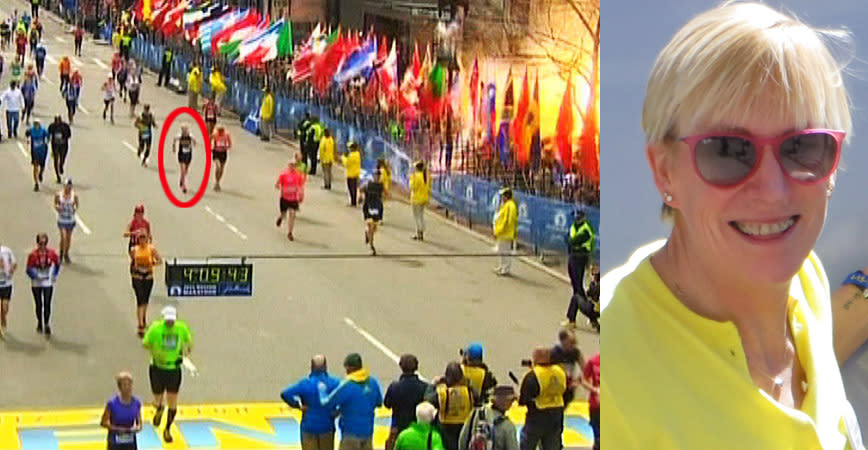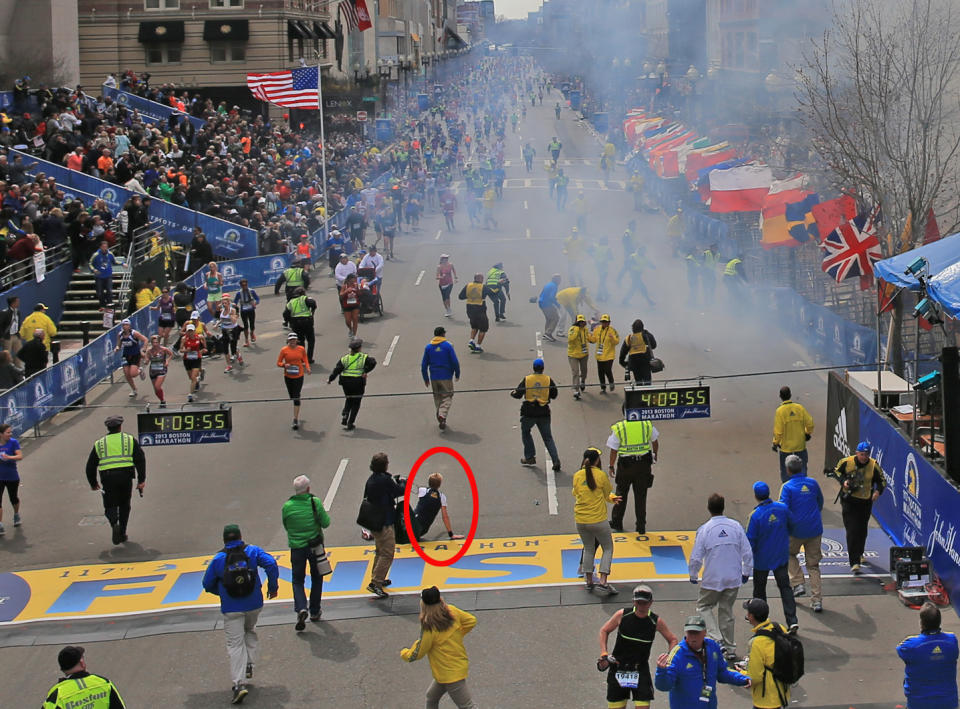I survived the Boston Marathon bombing, and I’ll be back this year — even if I have to walk

By Johanna Hantel
In the fall of 1998, a friend talked me into running a marathon. Crazy, I thought. I had no running experience and no idea how to train. I ended up running the Philadelphia Marathon and was hooked. I ran a second marathon six months later and qualified for the Boston Marathon. I was running, against the advice of my doctor, on a right knee that had seven surgeries, the result of a skiing accident.
Knowing what a big deal it was to qualify for Boston, there was no way I was not going to run it. But because of my knee, I developed extreme foot pain and had difficulty walking. The manager of a local running store suggested I see Dr. Howard Palamarchuk, known to many as “Dr. P.”
Dr. P. is a podiatrist and professor at the Temple University School of Podiatric Medicine. He is a former elite race walker, and has treated members of the Pennsylvania Ballet as well as many local elite runners. I felt he was out of my league but made an appointment anyway. I was nervous: Would he feel I was wasting his time?
I told Dr. P. I wanted to run just one more marathon. He brought me to Temple’s biomechanics lab, treating me like an elite runner, and conducted a gait analysis. He also designed shoe orthotics that made it possible for me to run my first Boston Marathon, and my second, and my third … and many, too many, other marathons.
Simply and literally, through various injuries over the years, Dr. P. kept me on my feet. Each time I saw him, we’d end up talking about the most recent Boston. For 30 years, Dr. P. has volunteered his time and expertise to bring a group of Temple students to the Boston Marathon to work in the race medical tent. I can’t think of a more valuable learning experience than treating runners’ feet at the end of 26.2 miles. Dr. P is modest about his years of volunteering, but he returns to that med tent year after year for the benefit of his students and to help the runners. Each year when I finished the race, I would try to sneak into the tent, pretending I was injured, just to say hi to Dr. P. He would be busy, but would always be happy to see me and congratulate me.

On April 15, 2013, I was running my 13th Boston Marathon. I was running on the far left side of Boylston Street and I was just about at the finish line when a bomb exploded. I was about 10 feet away from the explosion, which knocked me off my feet. I do not remember anything about the explosion except seeing an orange glow. I did not hear it or the second explosion that quickly followed.
Slideshow: Boston Marathon bombings — A look back >>>
Dr. P. was, as usual, working in the med tent that day with his students. As the injured were rushed through the tent, he confronted carnage usually seen only in wartime. I did not know what happened to Dr. P., and vice versa, until we ran into each other some weeks later, ironically in the med tent at the Broad Street Run. He was working, and I was supporting a friend. We were both there to try to recover some normality in our lives, which we now know, and I think we knew then, is not possible. We shared our traumatic stories with each other.
My injuries, some of which will be lifelong, included a ruptured eardrum and hearing loss, shrapnel wounds, broken fingers, a misaligned jaw and a blast-induced brain injury. All of this has affected my ability to run, but I knew soon after the bombing I had to attempt Boston the following year. Dr. P. also knew he had to go back, for his students and for himself. Not a day went by that he didn’t think about Boston, the maiming and brutality, how the med tent had suddenly become a mass casualty tent. He walked the course the day before by himself and made his peace with it.

As I was approaching the finish line in 2014, I wanted to be on the far right side, as far away from where the bomb exploded as possible. But the course layout forced me to run the final yards on the left side. As I reached the finish line, I broke down. I knew that the only person who would understand was Dr. P., and that I had to see him. Hysterical, I forced my way in to the med tent. Dr. P. gave me a huge hug, and left the med tent to stay with me until I calmed down and my friends found me. He was my rock that day.
In 2015, I faced one of the bombers, Dzhokhar Tsarnaev, in court before he was sentenced to death. I was one of the victims allowed to testify. “If I have to crawl,” I told him, “I am going to continue to run Boston each year … because I will not let this sickening act take that away from me.” I ran in 2015 and 2016, and despite a stress fracture in my foot, will run, or most likely walk, in a cast boot from Dr. P this year. I saw Dr. P. this week, and he will be in touch with me next Monday while he works in the med tent. It is grueling for me to go back each year, but knowing that I will find Dr. P. in the med tent when I finish the race makes it easier.
Johanna Hantel is a medical researcher from Malvern, Pa.
Read more from Yahoo News:
Trump warms to President Xi as relationship with Putin chills
Additional officers placed on leave over forcible passenger removal
GOP Rep. Yoho gets a pass from constituents after bucking Trump on health care
Column: The first 100 days don’t matter. For Trump they matter even less.
Photos: Parade of satire: Puck magazine Easter illustrations from cartooning’s Gilded Age



